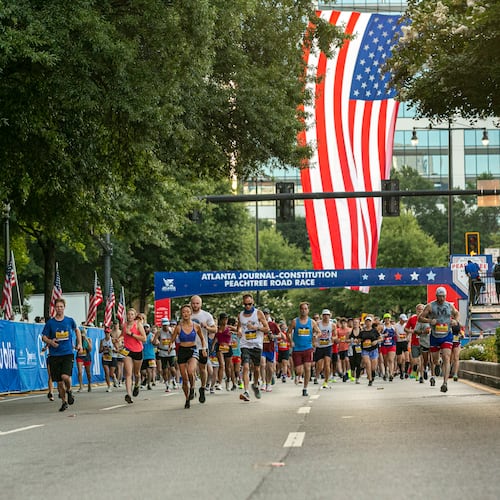Whether you’re a runner for fun or a novice in the fitness arena, running a 10K could be daunting.
For the uninitiated, a 10K is 10 kilometers or 6.2 miles. And that’s how long the AJC Peachtree Road Race, known as the world’s largest 10K, has been for decades.
That can seem like quite the challenge, even if you’ve run a 5K before, which is 3.1 miles.
“Do your homework. Not all 10K running plans are meant for all runners. If you’re a beginner, look for a 12 to 14 week plan. Intermediate and advanced runners will do fine with a 10 to 12 week plan. Also, look at the total weekly mileage,” personal trainer Thad McLaurin, owner of RunnerDude’s Fitness, told Active for training plans.
“More miles are not necessarily better. Quality runs such as hills, intervals, and tempo runs may not rack-up the mileage, but the conditioning they provide trumps lots of long steady-state miles.”
That’s one piece of advice, but here are five simple tips you can use to train for your next 10K.
Get familiar with the course
Whether it’s your first 10K or not, you’ll want to train according to the terrain of the route.
Verywell Fit advises runners to include hills on the route if they’re on the route. And there’s a huge one deemed Cardiac Hill on the AJC Peachtree Road Race. It reaches more than 12 stories in a single mile. But there are other aspects you need to know about, too, including etiquette at water stations and using port-a-potties.
Build endurance by walking
It’s a marathon, not a sprint, so endurance is going to be a key factor for successfully running in a 10K.
Fitday says after thoroughly stretching your arms and legs, walk for about five to 10 minutes to warm up before stretching again. After that, try to walk for about five miles, taking note of how you feel once it’s over. Repeat that for about a week so that your body can adjust to the distance and increase the distance each week after that.
The International Sports Science Association has several running workouts you can consider to build speed and endurance.
Keep the majority of training below race-day pace
Despite what runners of all experience levels may believe, you should train at a pace that’s a fraction of what you’ll run on the day of the race, according to RunToTheFinish.
“The effort has to be lower than you think it should be, because you’ve essentially made abnormal normal,” Greg McMillan, author of You (Only Faster) told Runner’s World. “What is really a moderate effort, you’re calling easy. So when you feel like you’re running easy, run easier.”
Do some strength training
No matter your experience level, strength training can be a helpful tool to make your 10K a success. You can run faster for longer with stronger glutes, according to Runkeeper.
“Strength work accomplishes three big goals for runners,” Jason Fitzgerald, USATF-certified running coach and funder of Strength Running in Denver told Runner’s World. “It prevents injuries by strengthening muscles and connective tissues; it helps you run faster by improving neuromuscular coordination and power, and it improves running economy by encouraging coordination and stride efficiency.”
Choose good pre-race meals
You’ll need to know the best way to fuel your body well before going into a 6.2-mile run — that includes the meals you consume in the weeks leading up to the race.
Louisiana’s largest nonprofit, academic healthcare system Ochsner Health noted you can maximize the carbohydrate storage your body builds while you tone down on the mileage you gain ahead of race day. Do this by trying to incorporate a source of carbohydrate with each meal and snack you eat all day long.
Don’t carbo-load, though — eat one or two slices of bread, a small serving of starches such as pasta or potatoes and yogurt, milk and fresh fruit are also good options of foods to incorporate.
About the Author
Keep Reading
The Latest
Featured


